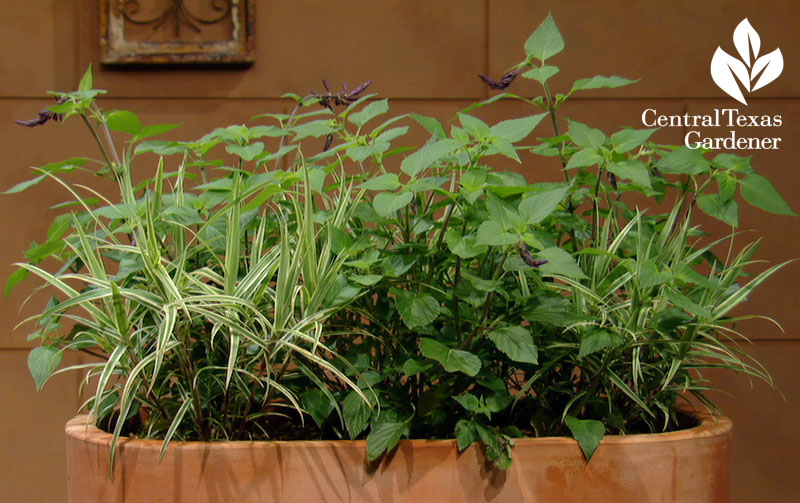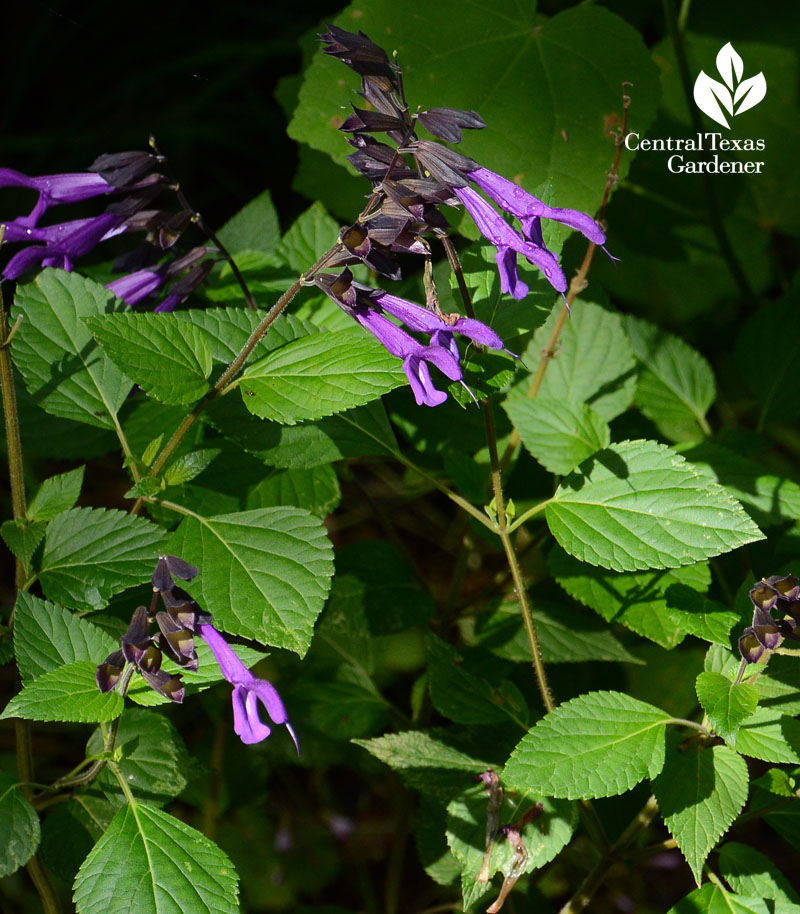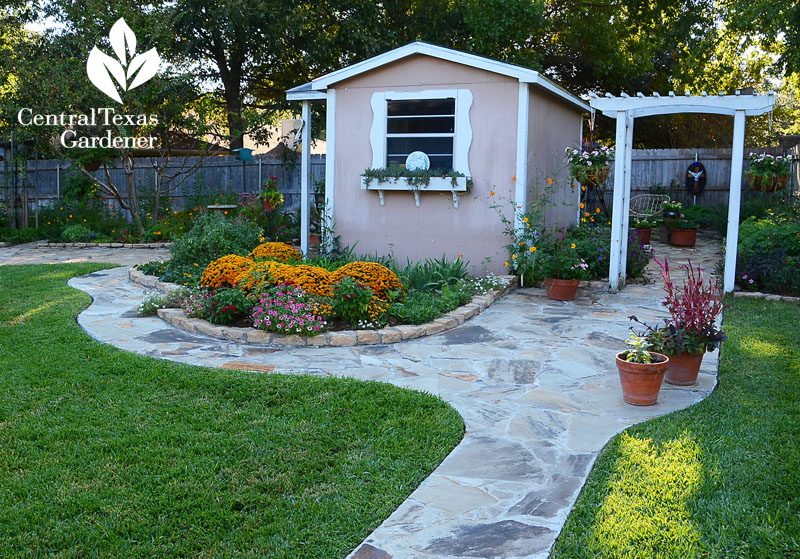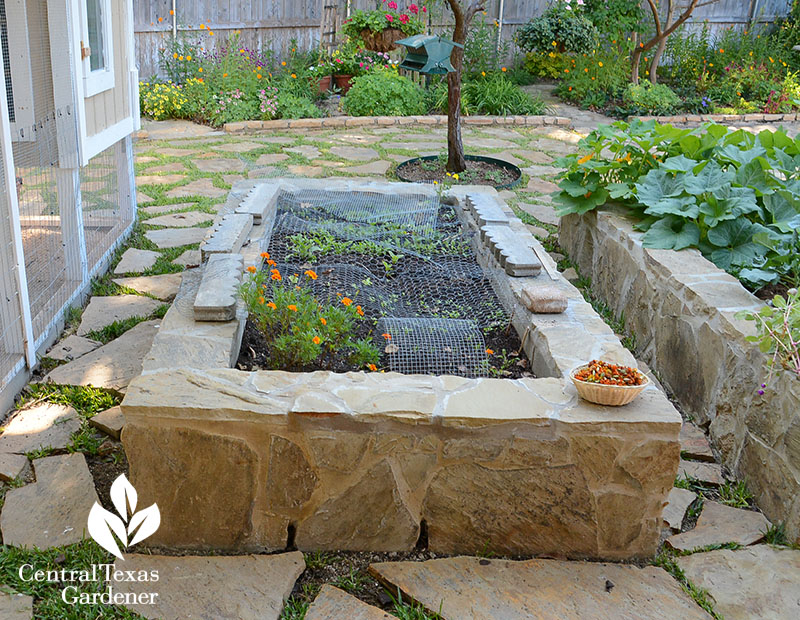May 3, 2018
Dramatic Light: Sedges, Sedums, Salvias
Aren’t these huggable? My Yucca pallida flowers are edible, too, as I learned recently. I chomped into one and yes, it was yummy! Maybe I’m a deer?

I love these silvery-leaved yuccas because they don’t whine about my Blackland Prairie soil and don’t mind shade to high light swings.
In deer country, we caught spring in action in this sun-to-shade front yard abloom with bluebonnets, Mexican feather grass, salvias, and Mexican stonecrop (Sedum mexicanum).

They replaced lawn with Berkley sedge—punctuated with rain lilies and Salvia lyrata. This is psycho lighting in earnest, where it swung from shade to sun and back to shade in just a few hours.

I didn’t have the best luck with Salvia lyrata, the native evergreen replacement for ajuga, until it seeded itself into decomposed granite cracks where it gets shade and a few hours of hard core sun. Its spiky spring blooms attract lots of pollinators.

This week, passionate plant woman Liz Morphis from Barton Springs Nursery takes on psycho light with “Sedges, Salvias, and Sedums!”

She dazzles the darker side that gets slammed with sunlight spurts. ‘Sparkler Sedge’ is a tolerant evergreen that she assures is more readily available these days.

I have a few, including one in a container to sparkle up a dim light spot with a bit of height. When leaves get leggy or brown, clip at the base. New spurts emerge fast.

Liz pairs ‘Sparkler Sedge’ with ‘Amistad’ salvia in a large container. In the ground, ‘Amistad’ is quite robust, growing at least 4’ x 4’.

Those large leaves welcome a bit of shade, for sure, but need some sun for the best blooms to attract hordes of bees and butterflies. A little extra water in summer’s heat doesn’t hurt.

Cherokee sedge is one I’m adding to my list! It’s a Blackland Prairie native that grows from Canada to Coahuila as a substitute for evergreen liriope.

When I visited Liz at BSN to finalize our list, earnestly she told me, “You’ve got to get Salvia greggii ‘Lemon Light.” How can you resist that? I couldn’t.

Here’s why: Liz tells us that ‘Lemon Light’ blooms constantly and is the most drought-tolerant greggii in her garden. What really sold me are the soft yellow flowers, here paired with sedeveria, an echeveria and sedum hybrid.
She brought along many cute as heck sedums, but here’s one: Chinese sedum (Sedum tetractinum) that blooms in waves of yellow for months.

SO much more, so watch now!

We keep up the passion with fun and funny Herb n’ Cowgirl Ann McCormick who’s got the secret for a container food forest: the three “P’s”—Pot, Plant & Place. Watch now!

Now, here’s a first for CTG, thanks to Jason Wisser! What are these reddish blobs on his oak tree?

We consulted AgriLife Extension entomologist Wizzie Brown who concludes that these are the result of gall midge larvae. Get Daphne’s complete answer about this early stage of gall formation and why they’re not a problem.
On tour: Growing up in Beirut, Sheila and Tim Smith learned that hospitality starts in a garden.

Now in Waco, guests dine on meals fresh from the picking and settle back to converse and stroll among the flowers busy with bees and butterflies.


She and husband Tim crafted their haven together, making modifications when Sheila was diagnosed with lupus. It’s become her healing place that energizes and strengthens.

Shelia tells us, “I love the idea of someone taking a walk through your back yard. So my pathways are designed to almost feel like a brook going around or a little riverbed.”

Over years, they gradually added flagstone paths to easily navigate flower beds where Sheila layers successive bloomers for wildlife food all year.

Since a garden shed is so prominent, Sheila and Tim made it cute, tucking in a secret garden behind.




She grows all kinds of herbs—especially for homemade tabbouleh—but uses quinoa now instead of bulgur in her mandatory gluten-free diet.
In raised stone beds, Sheila cultivates seasonal vegetables. Note the baskets of dried flowers she’s collected to re-seed the garden per season and to pass along to friends.

She protects seedlings with leftover chicken wire until they’re large enough to fend off critter scratching.

Her secret to success: homemade compost. Tim drilled holes into large trash barrels to allow rainfall and air. Now and then, Sheila rolls them around to speed up the process, which doesn’t take long.

Chicken poop (and fresh eggs) prompted their cute chicken coop that Tim crafted from recycled materials. Their hens were very young on our visit, so the roosting boxes were closed off.


In this cottage style habitat, their hospitality extends to pollinators, too. Butterflies and bees darted everywhere, like on annual cosmos that Sheila plants from last year’s seeds.

A Bordered Patch butterfly wanted to sign on as KLRU grip to assist audio guy Steve Maedl!

Watch the whole fun story now!
Thanks for stopping by! See you next week, Linda
tags:

